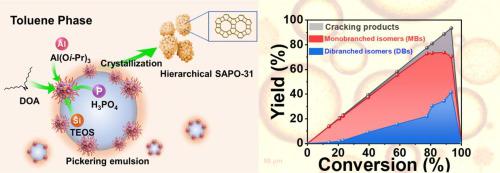Chemical Engineering Journal ( IF 13.3 ) Pub Date : 2023-02-13 , DOI: 10.1016/j.cej.2023.141887
Fan Yang , Qiuming Zhou , Jia Wang , Hongxin Ding , Xuedong Zhu , Kake Zhu , Weibin Fan

|
Silicoaluminophosphates (SAPOs) are a class of microporous solids employed as solid acid catalysts or adsorbents in petrochemical and coal chemical processes, which are often generated in hydrothermal synthesis using water-soluble organic structure-directing agents (OSDA), resulting in the formation of micron sized, rod-like crystals running along pore-channel direction for unidimensional SAPOs. The use of a low-cost, barely soluble di-n-octylamine (DOA) as OSDA in a water/toluene biphasic media to crystallize SAPO-31 is reported. The product is disclosed to be a hierarchically porous material built up of self-assembled nanocrystals (∼110 nm) with enhanced diffusion property and preserved acidity comparable to that of a standard sample derived using di-n-hexylamine as OSDA. The formation is mediated by the formation of a Pickering emulsion structure that favors crystal nucleation over growth, thus overcoming the solubility barrier of candidate OSDA. The obtained material exhibited higher isomer yield in catalytic hydroisomerization of n-dodecane compared to the control sample. Product distribution analysis discloses that mono-branched isomers are generated mainly inside the micropores, while di-branched isomers are produced via key-lock catalysis on pore-mouth sites. The increase in isomerization selectivity is attributed to the formation of more mono-branched isomers and their lowered cracking probability associated with enhanced diffusion property. This new synthetic protocol expands the toolkit of candidate OSDAs towards hydrophobic molecules and exemplifies porogen-free fabrication of hierarchical SAPOs. The uncovered origin of shape-selectivity offers a guidance towards manipulating hydroisomerization product slates.
中文翻译:

通过相转移合成克服二正辛胺作为多级硅铝磷酸盐合成中结构导向剂的溶解度障碍
硅铝磷酸盐 (SAPO) 是一类在石化和煤化工过程中用作固体酸催化剂或吸附剂的微孔固体,通常在使用水溶性有机结构导向剂 (OSDA) 的水热合成中生成,导致微米级的形成一维 SAPO 沿孔道方向运行的大尺寸棒状晶体。据报道,在水/甲苯双相介质中使用低成本、几乎不溶的二正辛胺 (DOA) 作为 OSDA 来结晶 SAPO-31。据披露,该产品是一种由自组装纳米晶体 (~110 nm) 构成的分级多孔材料,具有增强的扩散性能和保持的酸度,与使用 din- n衍生的标准样品相当-己胺作为OSDA。这种形成是由皮克林乳液结构的形成介导的,该结构有利于晶体成核而不是生长,从而克服了候选 OSDA 的溶解度障碍。所得材料在n的催化加氢异构中表现出较高的异构体产率-十二烷与对照样品相比。产物分布分析表明,单支链异构体主要在微孔内部产生,而双支链异构体则通过孔口位点的键锁催化产生。异构化选择性的增加归因于更多单支化异构体的形成及其与增强的扩散性能相关的较低的裂化概率。这种新的合成协议将候选 OSDA 的工具包扩展到疏水性分子,并举例说明了分层 SAPO 的无致孔剂制造。形状选择性的发现来源为操纵加氢异构化产物结构提供了指导。

































 京公网安备 11010802027423号
京公网安备 11010802027423号